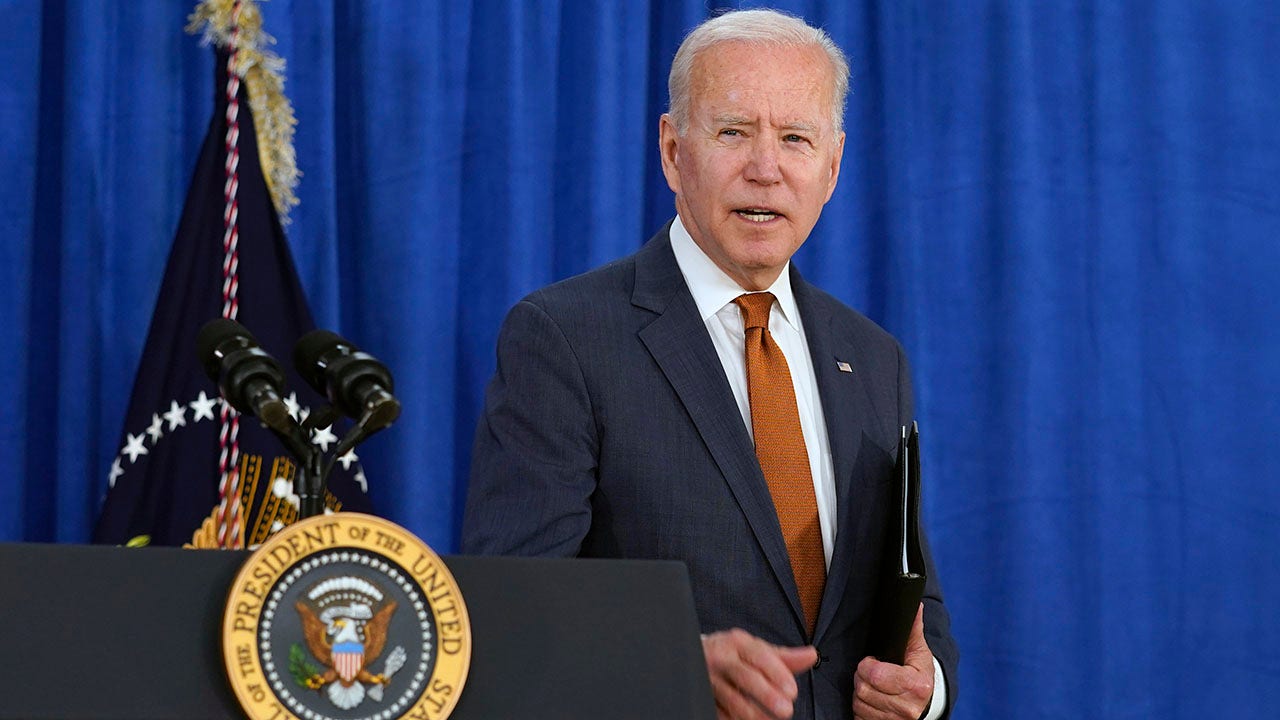Business
Pasadena's Ambassador Auditorium, 'Carnegie Hall of the West,' goes up for sale

The storied Ambassador Auditorium in Pasadena, which was long considered one of the region’s top classical music venues, is for sale after being owned by a local church for the last two decades.
Harvest Rock Church is asking $45 million for the 1,200-seat auditorium near the Old Pasadena district that has also hosted jazz greats including Ella Fitzgerald, Dave Brubeck and Dizzy Gillespie. It has been called “the Carnegie Hall of the West” by fans.
The evangelical Christian Harvest Rock Church is based on the property and uses the auditorium for services. It also rents the venue to the Pasadena Symphony and the Colburn Orchestra as well as other performers that the church finds compatible with its religious mission.
The church recently paid off its mortgage on the property, Pastor Che Ahn said, and decided to sell it to make a move to a bigger facility somewhere in the Los Angeles region.
The lobby of the Ambassador Auditorium in Pasadena includes a chandelier composed of 100 custom bulbs and 1,390 crystals in three tiers of polished bronze.
(Ambassador Foundation of Pasadena)
“We’re hoping that someone will buy it to really restore it to the original purpose and intent of that building,” he said.
The Ambassador Auditorium was intended to be a showplace for live performances when it opened in 1974. The Times called it “A new Taj Mahal for the arts.”
It was also the centerpiece for Ambassador College, operated by the Worldwide Church of God on a 40-acre campus near the intersection of Colorado and Orange Grove boulevards that has been largely redeveloped in recent years.
Harvest Rock Church and Maranatha High School bought a 13-acre portion of the campus site with five buildings including the auditorium from Worldwide Church of God in 2004 for an undisclosed amount. The auditorium controlled by Harvest Rock Church is assessed at $13.5 million, public records show.
Ambassador College founder Herbert W. Armstrong was a televangelist who set out to call attention to his ministry by building a lavish auditorium where he could broadcast services and host high-profile nonreligious events, including an opening performance by the Vienna Symphony Orchestra on April 7, 1974.
The auditorium made a big impression on local music aficionados, said Donna Perlmutter, who was a music critic at the Los Angeles Herald Examiner newspaper when it debuted.
“We were, at the time, bowled over by the presence of it,” she said. “It was to compare with any marvelous auditorium in Europe.”
That it had been created by a bombastic radio and television evangelist known for making dark end-times prophesies seemed unusual, she said.
“It was almost comical to think of who it was who erected this magnificent place,” Perlmutter said of Armstrong. “It was such a weird juxtaposition.”
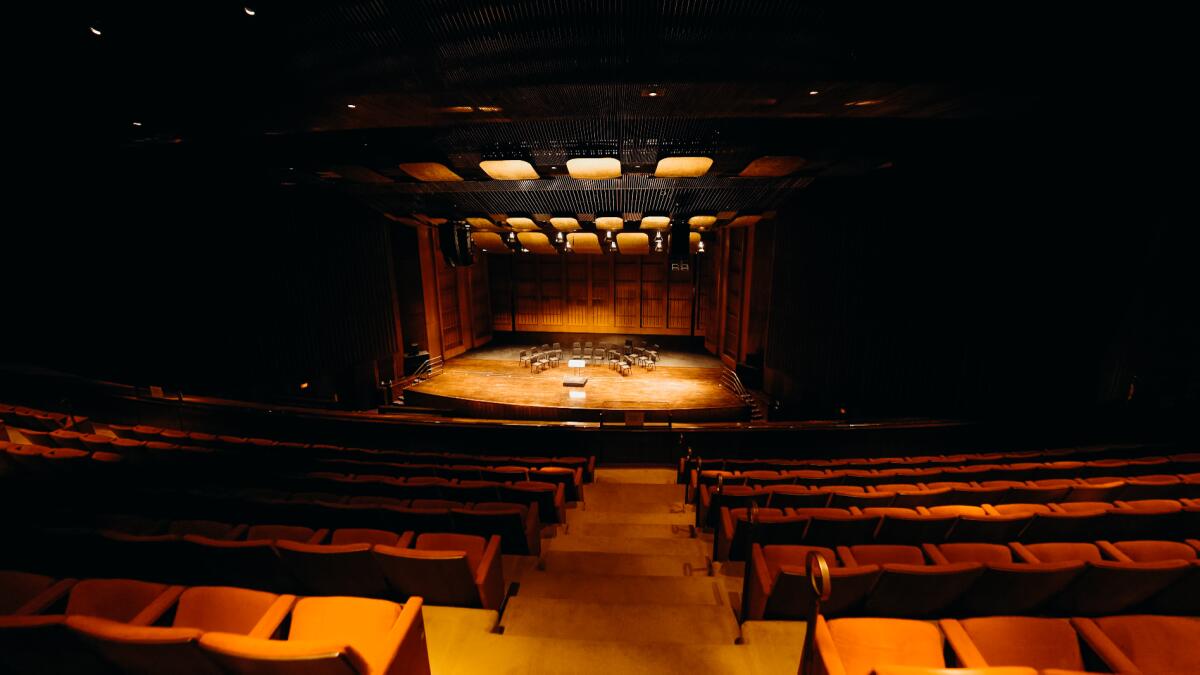
Jazz greats who have performed in the 1,200-seat Ambassador Auditorium in Pasadena include Ella Fitzgerald, Dave Brubeck and Dizzy Gillespie.
(Ambassador Foundation of Pasadena)
The acoustics are “optimal,” she said. “It bears a bright, undistorted sound. No singer could want more.”
The hall’s design by the architectural firm Daniel, Mann, Johnson & Mendenhall (DMJM) strived for a mid-century version of glamour, with a main lobby chandelier composed of 100 custom bulbs and 1,390 crystals in three tiers of polished bronze.
Finishes include walls of Brazilian rosewood and rose onyx, African shedua wood railings and ceilings adorned with hand-rolled 24-carat gold leaf.
The auditorium is set in a 500,000-gallon water pond that holds a 37-foot solid bronze egret sculpture designed by British sculptor David Wynne, who also famously made a bronze sculpture of the Beatles’ busts in 1964 and is said to have introduced them to Maharishi Mahesh Yogi.
Potential buyers of the auditorium include the city of Pasadena, private investors, or a group of investors seeking “to acquire a landmark with profound historical significance,” said real estate agent Isidora Fridman of Compass, who has the listing with Lauren Rauschenberg. The property at 131 S. St. John Ave. will officially go on the market July 9, Compass said.

Business
NASA astronauts spend unexpected July 4 on the International Space Station

Astronauts Suni Williams and Butch Wilmore spent an unexpected Fourth of July aboard the International Space Station — but it was hardly a patriotic display of engineering prowess.
The two NASA astronauts docked with the orbiting lab June 6 for what was supposed to be an eight-day mission, but their return home may be delayed for months in what has become a star-crossed test flight for Boeing’s new Starliner capsule.
Not only was the launch of the spacecraft with astronauts aboard for the first time repeatedly delayed due to multiple problems, but NASA and Boeing are taking a cautious approach in returning the pair to earth largely due to five thrusters that malfunctioned during docking.
Four of the tiny engines that direct the craft in space are now working properly, but engineers don’t have a clear understanding of what caused the shutdown, so they have decided to conduct ground tests at NASA’s White Sands Test Facility in New Mexico, NASA officials said. The tests will put a Starliner thruster through its paces in a replicated space environment.
The delay also will allow engineers to further study a helium leak in the capsule’s propulsion system that was first detected prior to launch and worsened as Starliner made its way up to the space station roughly 250 miles above earth. The gas is used to pressurize the Starliner’s propulsion system.
However, both the company and space agency stressed at a press conference earlier this week that the astronauts are not stranded in space and, if need be, they could board Starliner and return to Earth immediately if there is an emergency aboard the space station.
“We’re not stuck on ISS. The crew is not in any danger, and there’s no increased risk when we decide to bring Suni and Butch back to Earth,” said Mark Nappi, manager of Boeing’s Commercial Crew Program.
Ken Bowersox, an associate administrator at NASA, said the delay will allow for the collection of more data and that there is no hurry to bring the astronauts back. “We have the luxury of time,” he said.
Before launch, NASA had said the batteries aboard Starliner were rated for 45 days but during the press conference they indicated they were performing well and would be rated to last another 45 days. On regular missions to service the station, Starliner would stay docked for six months.
NASA and Boeing also will not have a chance to examine the thrusters or investigate the helium leak when Starliner returns since the propulsion system is jettisoned before the return to earth.
Nevertheless, the desire to conduct ground tests expected to take weeks has highlighted yet again how far Arlington, Va.-based Boeing, the world’s largest aerospace company, has fallen behind Elon Musk’s Hawthorne upstart SpaceX — at least in the program to service the space station.
Both companies were given multibillion-dollar contracts in 2014 to develop their crafts, and since 2020 Elon Musk’s Hawthorne company has ferried more than half a dozen crews aboard its Crew Dragon capsule to the station — while Boeing has managed only two remote flights, including a first that failed to reach orbit and a second in May 2022 that docked with the orbiting lab.
The current mission with astronauts aboard was scheduled to launch last year but was delayed due to the need to replace flammable tape used extensively in Starliner and a second issue with the parachute system that will slow its descent for a ground landing in the Southwest.
Then, this year’s May 6 launch date was repeatedly delayed, at first due to a malfunctioning valve on the Atlas V rocket that launches Starliner into space. The workhorse rocket is manufactured by United Launch Alliance, a joint venture of Boeing and Lockheed Martin.
Additional launch dates were missed due to the helium leak, believed caused by a single defective seal, so software fixes were developed to work around it — but then additional leaks developed after the launch. However, NASA and Boeing officials says the craft has 10 times more helium than it needs to return to earth.
Boeing has reportedly had to absorb $1.5 billion in Starliner cost overruns, even as it continues to deal with the fallout from the two crashes of its 737 Max 8 jets in 2018 and 2019.
The company is weighing whether to plead guilty to a charge of fraud over allegations it misled regulators who approved the new, larger version of the 737, including how much flight training pilots would need, according to the Associated Press.
Boeing also announced plans this week to acquire Spirit AeroSystems, a key supplier it had spun off in 2005 as it moved to outsource more work on its commercial jets. Spirit supplied the fuselage of the Alaska Airline Max 9 that experienced a panel blowout Jan. 5 on its way to Ontario International Airport in San Bernardino County. Boeing’s chief executive called the acquisition “in the best interest of the flying public.”
Meanwhile, SpaceX last month was awarded a NASA contract worth as much as $843 million to build a spacecraft to guide the International Space Station out of orbit so it can burn up in the atmosphere when it is retired in 2030.
Bloomberg reported last month that the privately held company is now valued at a record $210 billion following a company tender offer to insiders that priced shares at $112.
Should Starliner get certified, the dismantling of the space station would leave the spacecraft with only a handful of scheduled service flights, prompting speculation that Boeing may end the program.
However, the company says it has plans for Starliner to service the Orbital Reef orbiting station in development by Jeff Bezos’ Blue Origin space company.
Business
Opinion: Happy birthday, Amazon? Why one longtime user isn't celebrating the tech behemoth's 30th
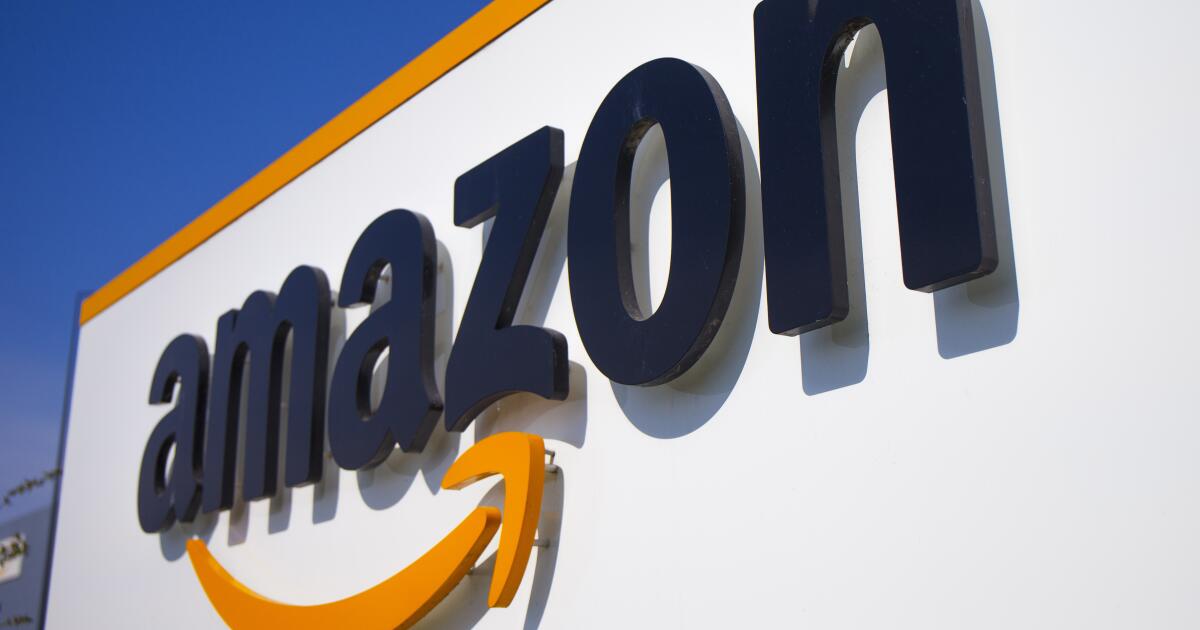
I had just started my master’s degree in artificial intelligence when a classmate asked if I’d heard of Amazon, a new online bookstore where you could order basically any book in the world and have it shipped to your front door. Feeling all the excitement of a middle school book fair flooding back, I entered the world of Amazon.com and ordered a beautiful book. It felt revolutionary and futuristic but still cozy and personal. At the end of that year, 1995, Amazon sent loyal customers, including me, a free coffee mug for the holidays.
It would have been hard to imagine then that the small business famously run out of Jeff Bezos’ Bellevue, Wash., garage would be celebrating its 30th anniversary and a mind-bending $1.97 trillion net worth today. I continue to use Amazon to order gadgets and basic necessities, watch movies and shows and read books on a Kindle. I do all of this even though I know the once-beloved bookseller has become a data-hungry behemoth that is laying waste to personal privacy.
Today, Amazon sells basically everything and knows basically everything, from our favorite toilet paper to our kids’ questions for Alexa to what’s going on in our neighborhoods — and has let police in on that, too! Amazon knows where we live, what our voices sound like, who our contacts are, how our credit histories are, at what temperature we like to keep our homes and even whether we have allergies or other health issues.
Based on this information, the company infers a whole profile: It potentially knows whether we’re gay or straight, married or divorced, Republican or Democratic, sexually active or not, religious or secular. It knows how educated we are and how much money we make. And it uses this data to sell to us better.
As a privacy researcher, I advocate for strong consumer privacy protections. After spending the better part of a decade going through privacy policies with a fine-tooth comb, I can safely say that Amazon has been worse for privacy than nearly any other company. It’s not just that Amazon has awful privacy policies; it’s also that, along with Facebook and Google, it co-authored our terrible targeted-ad economy, built on siphoning as much data as possible from users so that anyone with access to it can manipulate you into buying more stuff.
Considering the importance of freedom to America’s origin story, it’s ironic that the country is so beholden to a company that has manipulation of our free will down to a science.
“Did you just buy these Italian coffee beans?” Amazon asks us. “Here’s what you should buy next.”
Privacy and free will are inextricably intertwined: Both rest on being left to decide who we are, what we want and when we want it without anyone watching or interfering. Privacy is good for our mental health and good for society. Neither corporations nor governments — which have a way of acquiring the data the companies collect — should have access to unlimited knowledge about who we are and what we do all the time.
Amazon has played a pivotal role in making that possible. Its war on privacy took a particularly dystopian turn recently in Britain, where some train stations were using an Amazon artificial intelligence system called Rekognition to scan passengers’ faces and determine their age, gender and emotional state, whether happy, sad or angry; identify supposedly antisocial behavior such as running, shouting, skateboarding and smoking; and guess if they were suicidal. It’s like Orwell’s thought police came to life, but instead of Big Brother, it’s Big Bezos.
The worst part is that we just went right along with this intrusion in exchange for cheap stuff and free two-day shipping.
Unfortunately, Amazon has become almost a basic necessity. But we can take steps to rein in its worst consequences.
Consumers shouldn’t bear the burden of making Amazon better; policymakers and regulators should. A good place for them to start is with the American Privacy Rights Act, legislation currently before Congress. It isn’t perfect, but it would at least address our glaring lack of a federal privacy law. State privacy laws form a patchwork that varies widely in how well it protects consumers.
We need to start thinking of data privacy as a human right. The idea that companies have a right to all the data they can collect on and infer about us is absolutely bonkers. Thirty years ago, no one would have agreed with it.
This isn’t how the world should work, and it’s particularly terrifying that this is where we are as we enter the age of artificial intelligence. Generative AI programs, like the chatbots we hear about constantly, are designed to root out as much personal information as they can, supposedly to make them more effective. And Amazon is upgrading its Alexa assistant to incorporate generative AI technology.
Nothing I can impulse-buy on Amazon will help me feel better about a future with no privacy, mass surveillance and pervasive monitoring of our feelings and tendencies. What started as a beautiful book and a free mug has yielded a world where everything I buy, everywhere I go and, perhaps in the not-so-distant future, every emotion I feel can be tracked and turned into inferences to sell me more stuff or push dangerous ideologies or advance any other purpose that corporations or governments deem useful. If it sounds dystopian, that’s because it is.
Jen Caltrider is the director of Mozilla’s *Privacy Not Included project.
Business
Dear USPS: This California town wants its post office back
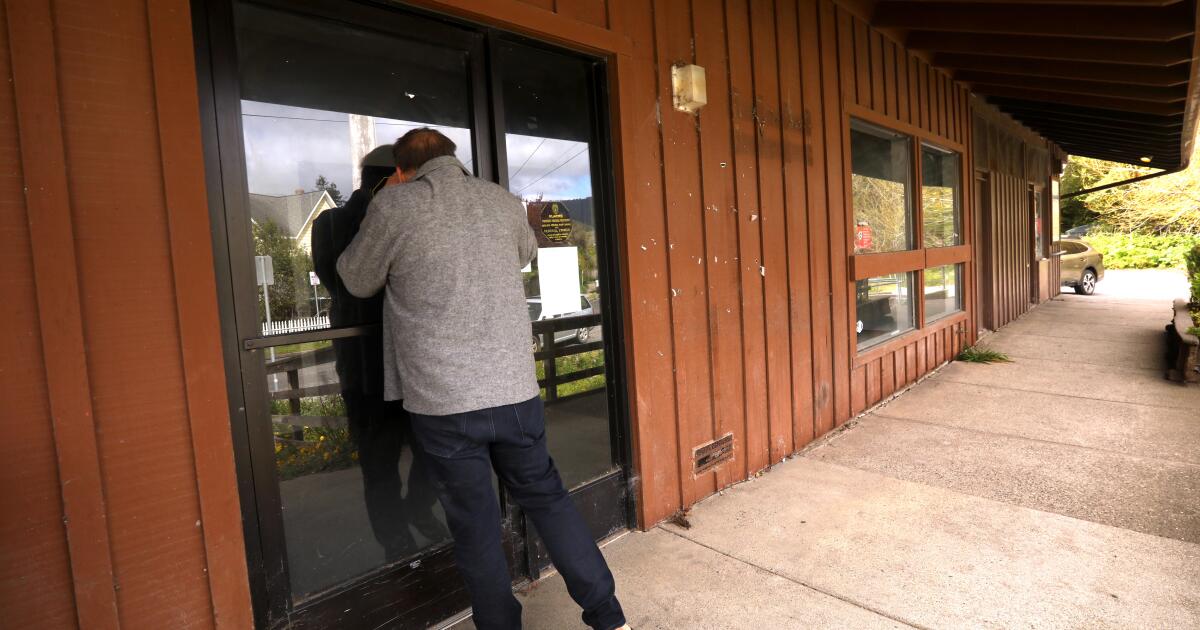
On the outskirts of this coastal village — just past the road sign telling visitors they are “Entering a Socially Acknowledged Nature-Loving Town” — a big wooden placard displays a set of hand-painted numbers. They are changed each morning.
“Days Without a Bolinas Post Office,” the sign reads.
On June 1, that number hit 456.
That’s how long it has been since the U.S. Postal Service was booted from its office in downtown Bolinas amid a fight with its longtime landlord.
In this artsy little town in west Marin County — a haven for poets and painters, writers and actors — the loss hit hard. The 1,500 citizens of ZIP Code 94924 have fought to get their post office back with their most cherished tool: creativity.
They have picketed with placards reading, “Real Mail Not Email!” They have marched in local parades dressed as letter carriers. They have composed songs and written poems and sent thousands of letters, in hand-painted envelopes, to USPS officials.
They even drafted their own plan for a temporary post office, offered to fund it, and sent it to Congress.
“It’s a very Bolinas approach, breaking through bureaucracy through art and culture and pleas,” said John Borg, who is helping lead the citizens campaign. “This has taken way longer than it should.”
The approach is quirky, but the loss is serious.
A sign at the entrance of Bolinas counts the days the small coastal town has been without its post office.
(Genaro Molina / Los Angeles Times)
Most people in this aging rural community abutting the Point Reyes National Seashore do not get home delivery. They relied upon daily trips to the post office for parcels, pension checks and mail-order prescriptions, not to mention the chance to catch up on the small-town scuttlebutt.
Now, they must drive at least 40 minutes round-trip, through the forest on Highway 1, to a flood-prone post office at a campground in the even smaller town of Olema.
Enzo Resta, a longtime resident and founder of the new Bolinas Film Festival, compared reaction to the loss of the post office with the so-called “hype cycle” around new technologies.
“There was the crash, where there was a lot of hope and indicators we would get it back — the peak of inflated expectations,” he said. “When it got pushed a little further, we kind of went into the valley of despair, and we’re just trying to crawl back out.”
The Bolinas post office shut down on March 3, 2023. It had occupied half of an unadorned single-story wooden building on Brighton Avenue — most recently shared with a liquor store — for six decades.
The USPS already was a tenant when Gregg Welsh, of Ventura County, acquired the building about 50 years ago. His family trust currently owns it.
The relationship between landlord and tenant soured long ago.
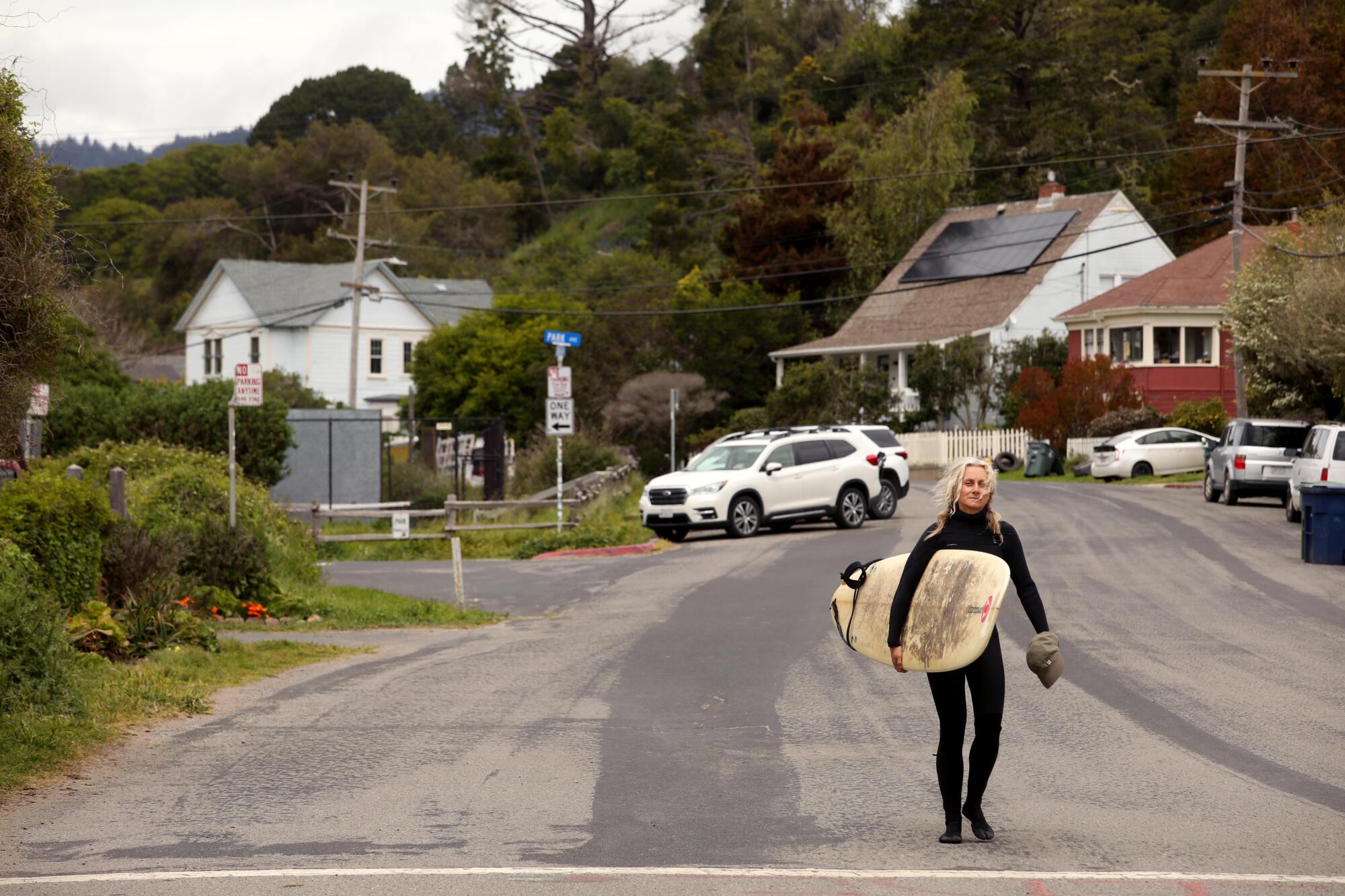
Most people in Bolinas do not get home delivery and relied upon daily trips to the post office for their parcels, pension checks and mail-order prescriptions.
(Genaro Molina / Los Angeles Times)
According to a statement provided by Welsh through his attorney, Patrick Morris, the USPS for years violated its lease, which required it to maintain and repair the flooring at its own expense.
The postal service, the statement reads, discovered asbestos in the floor tiles in 1998, but essentially kept it hidden from the landlord for more than two decades and did not post warning signs for the public or employees.
When Welsh visited the Bolinas post office in late 2020, the statement reads, he saw worn and broken tiles and exposed, deteriorating subfloor materials.
The landlord and the postal service tussled over who should pay for repairs and asbestos abatement.
The USPS lease, according to the statement, ended in January 2022, with the parties still arguing over the floor. The postal service continued to occupy the building, sans lease, as a “tenant at sufferance.”
In a February 2023 email to USPS officials, which Morris provided to The Times, Morris said his client had not yet evicted the post office, in part because he had not wanted to deprive Bolinas residents of postal facilities before it could find a new location. But at that point, Welsh had had enough. He demanded the post office vacate the building within a month.
Kristina Uppal, a Bay Area-based spokeswoman for the USPS, did not respond to questions from The Times about accusations made by the landlord or about the alleged presence of asbestos in the building. She said the USPS was “forced from the old facility due to the unexpected termination of a lease,” but that there are no plans to permanently close the Bolinas post office.
“We are just as eager to resume retail operations in Bolinas as the community and provide enhanced accessibility such as expanding street delivery to alleviate any inconvenience,” Uppal wrote.
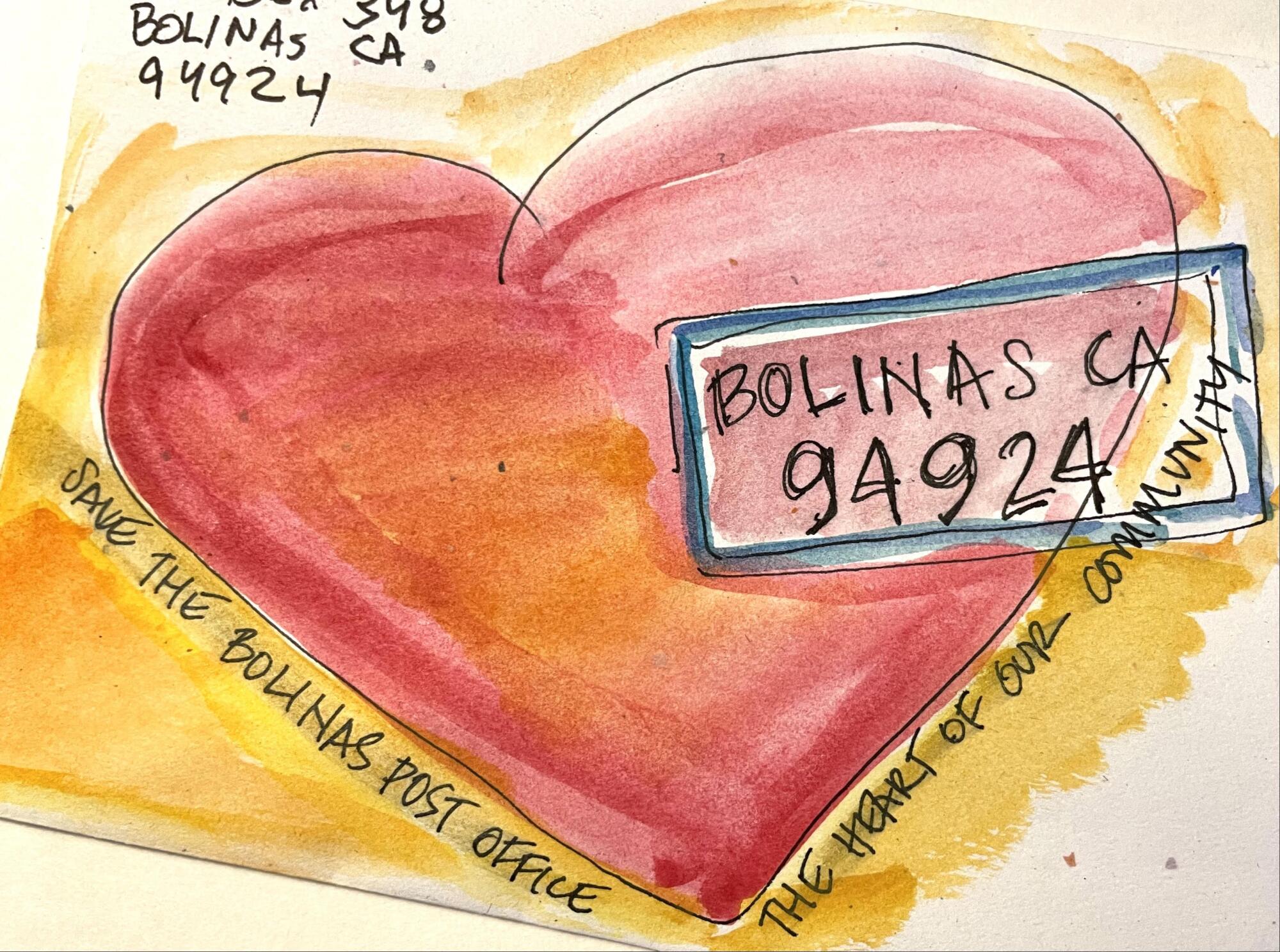
Bolinas residents sent more than 2,500 “art” letters with personalized appeals asking U.S. Postal Service officials to resurrect mail service in their town.
(John Borg)
Residents want their post office back, but their trust in the USPS has frayed.
The dust-up in Bolinas comes as U.S. Postmaster Louis DeJoy, appointed when former President Trump was in the White House, is under fire for efforts to consolidate postal facilities. In a May letter, a bipartisan group of U.S. senators criticized his 10-year plan, Delivering for America, arguing that cost-cutting measures have degraded service and disproportionately affected rural communities.
Bolinas residents say they have had little direct communication from the USPS over the last 15 months. Bolinas, they note, had a post office since 1863, but townsfolk were given less than two weeks’ notice before it closed.
Their mail has been bounced around — rerouted first to Olema, then to nearby Stinson Beach because of flooding, then back to Olema. Sometimes, their letters were left in unsecured bins on outdoor tables.
The relocation has been more than just an inconvenience for the town’s elderly residents, many of whom cannot drive. There is little public transit, and more than half the town’s residents are 65 or older.
People began reporting problems getting mail-order medication soon after the post office closed, according to the Marin County Board of Supervisors. They also have struggled to get lab results and healthcare coverage updates.
Borg, 62, is a type 1 diabetic who had his insulin delivered through the mail before the closure. Now, he said, package delivery is so iffy that he drives two hours round-trip to San Rafael each month to pick it up at a pharmacy.
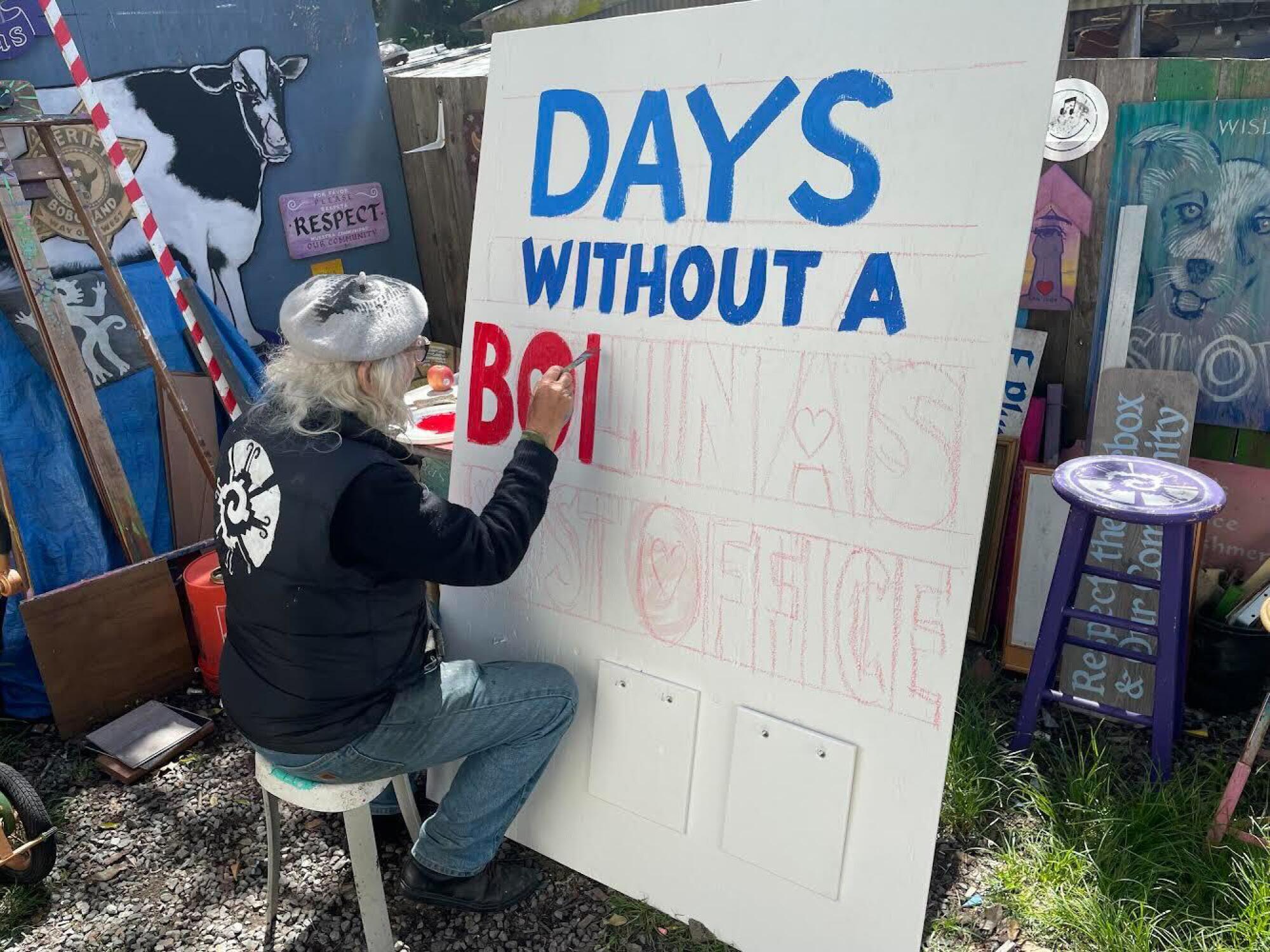
Bolinas’ poets and painters have been integral to the town’s campaign for a post office. Here, an artist who goes by StuArt, creates the sign that will count the days Bolinas goes without service.
(John Borg)
Borg runs a small business, making stainless steel drinkware, and has had two five-figure checks for his company lost in the mail.
He said residents of the unincorporated town — which has no mayor or city attorney advocating on their behalf — had to band together to make their voices heard.
Appealing to the outside world is a tall order for a place so famously reclusive that, for years, a vigilante band called the Bolinas Border Patrol stole road signs on Highway 1 directing travelers into town. Once, when the California Department of Transportation tried painting BOLINAS on the blacktop, sneaky citizens promptly blacked them out with tar.
“We’re a small village that kind of likes to keep to ourselves and deflect attention and not be super profile. But we’re in the process where the town is changing,” said Borg, noting that a growing share of Bolinas’ limited housing stock is being used as second homes for the wealthy and short-term vacation rentals.
“The one thing that holds this place together is the post office.”
There has been no viable commercial real estate in tiny Bolinas for the post office to move into permanently. And a 1971 water meter moratorium has effectively prohibited development for the last 53 years. The moratorium, which has been challenged and upheld in court, was put into place because Bolinas has a limited water supply, mostly coming from the Arroyo Hondo Creek in the Point Reyes National Seashore.
Last spring, residents drafted a detailed proposal for a temporary facility — a mobile office trailer on a parking lot next to the fire station — and offered to raise $50,000 for its installation.
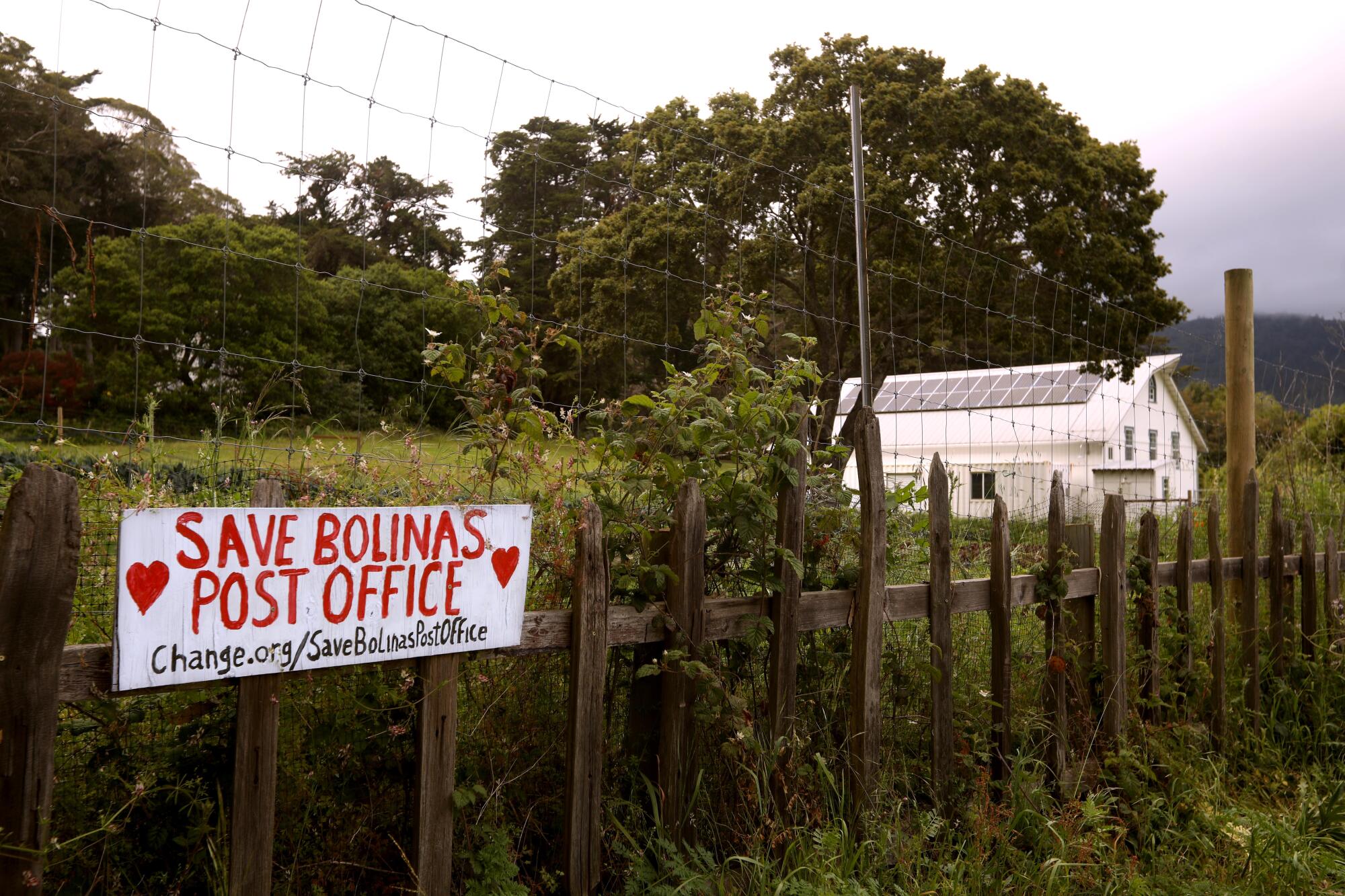
Bolinas residents note they were given just two weeks’ notice that their post office — a fixture in town since 1863 — was closing.
(Genaro Molina / Los Angeles Times)
They sent the plan to a supportive Rep. Jared Huffman (D-San Rafael), who shipped it to DeJoy. A spokesperson for Huffman said his office has been in frequent contact with the USPS and shares the community’s frustration over the slow process.
Uppal, the USPS spokeswoman, said the agency has “reviewed proposals” and “will select a site that best meets our operational needs and can provide continued service to the community long term.”
“I can confirm there is a potential option that is under review now,” she wrote. She did not provide details.
In his written response to questions from The Times, Welsh, through his attorney, said there has been discussion with USPS about moving back into its former building. No further details were provided.
For now, Bolinas residents continue to haul up to Olema — and to lionize the simple pleasure of picking up their mail locally. Or, as one local poet put it in an ode penned for a “Save the Post Office” rally:
I have gossip to send to Tomales,
regrets to send to Limantour Beach.
But it’s Bolinas — always Bolinas — I dream of finding
in the return address of a letter sent to me.
-

 News1 week ago
News1 week agoToplines: June 2024 Times/Siena Poll of Registered Voters Nationwide
-

 Politics1 week ago
Politics1 week agoPopular Republican and Trump running mate contender makes first Senate endorsement in 2024 races
-

 Politics1 week ago
Politics1 week agoThe many faces of Donald Trump from past presidential debates
-

 News1 week ago
News1 week agoIowa floodwaters breach levees as even more rain dumps onto parts of the Midwest
-

 Politics1 week ago
Politics1 week agoMike Kennedy advances past crowded GOP primary to secure nomination for open Utah House seat
-

 News1 week ago
News1 week agoNew Jersey gamer flew to Florida and beat fellow player with hammer, say police
-

 News6 days ago
News6 days agoVideo: How Blast Waves Can Injure the Brain
-
/cdn.vox-cdn.com/uploads/chorus_asset/file/25505687/VERNE_Exterior1.jpg)
/cdn.vox-cdn.com/uploads/chorus_asset/file/25505687/VERNE_Exterior1.jpg) Technology1 week ago
Technology1 week agoRimac is shifting from electric supercars to robotaxis











